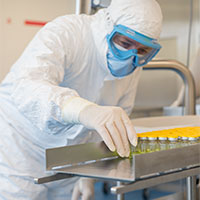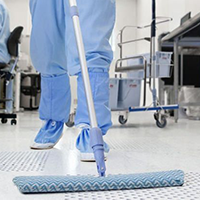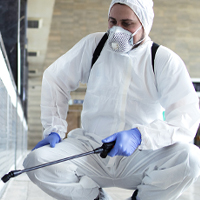Controlled Environment
Controlled Environment and Cleanroom Solutions
Cleanrooms and other controlled environments used for scientific research or manufacturing pharmaceuticals, semiconductors and other electronic products require a host of specialized products. Avantor has the products and supplies you need to maintain cleanroom standards.
Controlled Environment Workflows
Avantor offers a comprehensive range of products to meet the specialized needs of cleanrooms and controlled environments that require ultraclean conditions for research, manufacturing, and other processes. We offer controlled environment products from industry-leading manufacturers to support biotechnology, pharmaceutical, microelectronics, semiconductor, medical devices, aerospace, automotive, and other industries.

Pharmaceuticals, Biotechnology, and Medical Devices
Manufacturing facilities for pharmaceuticals, biotechnology products, and medical devices are controlled aseptic environments that meet stringent standards for cleanliness, air quality, airflow, temperature, humidity, and other measures.

Healthcare
Cleanrooms in hospital pharmacies, surgical units, isolation rooms, burn units, or other areas are more common than ever as health systems work to reduce hospital-acquired infection and control the spread of airborne particles and microorganisms.
Semiconductor and Microelectronics
Cleanrooms are critical to the semiconductor and microelectronics industry. Contamination is a major source of manufacturing issues, and product failure, so static, particulate matter, outgassing, and other contaminants must be controlled.

Aerospace and Automotive
There is little room for error in aerospace and automotive assembly because a single defect can cause catastrophic failure. That’s why both industries must maintain controlled cleanroom environments for some manufacturing processes.
What is a Controlled Environment?
A controlled environment is one in which multiple environmental factors are monitored and controlled using controlled environment equipment. The controlled parameters typically include:
- Particulates
- Humidity
- Temperature
- Pressure
- Segregation
What is a Cleanroom?
Cleanrooms are controlled environments that limit the number of pollutants, or contamination, to a specified number of particles (by size) per cubic foot or cubic meter. Cleanrooms are tested regularly to ensure standards are met, and systems are in place to control the environment by limiting dust, chemical vapors, airborne microbes, and aerosol particles.
Cleanrooms are used by manufacturing companies when a high level of sterility is necessary to avoid adversely affecting the product being manufactured. Cleanroom solutions vary based on the manufacturer’s needs and are used in a variety of industries, including:
- Pharmaceutical
- Biotech
- Medical device
- Life sciences
- Aerospace
- Semiconductor manufacturing
- Optics
- Military
- Department of Energy
Controlled environment equipment is used to reduce particulate contamination and ensure the humidity, temperature, air pressure, and other environmental factors are kept within the appropriate parameters.
What Are the Standards for a Cleanroom?
The standards for a cleanroom are based on the number of particles measured in one cubic foot or one cubic meter of air. Cleanrooms are classified using either the Federal Standard 209E of the USA or ISO 14644-1 standard.
Federal Standard 209E classifies cleanrooms with numbers like “class 1,000” or “class 10,000,” and classifications are based on the number of particles of size 0.5 μm or larger allowed in one cubic foot of air.
ISO 14644-1 standard classifies cleanrooms with smaller numbers like “3” and classifications are based on a decimal logarithm of the number of particles 0.1 μm or larger allowed in one cubic meter of air.
What Type of Equipment and Supplies Are Necessary to Make Sure a Cleanroom Meets Necessary Standards?
The type of controlled environment lab equipment and supplies necessary to make sure a cleanroom meets necessary standards includes:
- High-Efficiency Particulate Air (HEPA) filters
- Ultra-Low Particulate Air (ULPA) filters
- Airlocks
- Air showers
- Special gowning designed to trap contaminants
- Environmental monitoring
 Literature
Literature